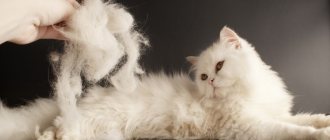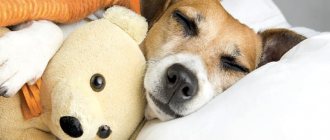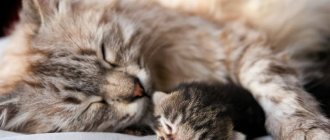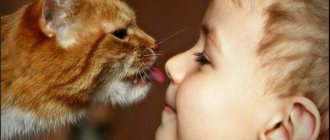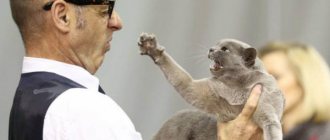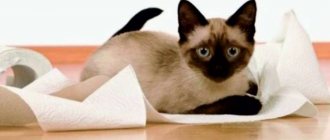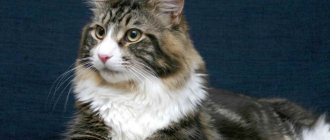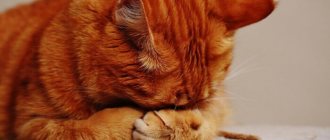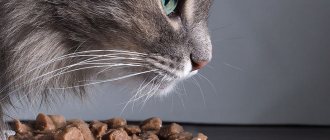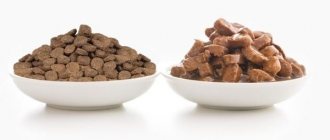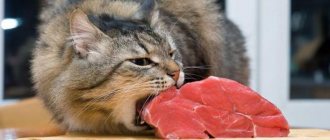What will you learn from the article?
- Ready-made food for nursing cats Acana Wild Prairie
- ProNature Holistic For adult cats (1+) “Duck with orange”
- Bosch Sanabelle Kitten
- Eukanuba Kitten Healthy Start
- 1st Choice "Healthy Start" for kittens
- Hill's Science Plan Optimal Care
- Protein products
- Walnut infusion
I think you will agree that pregnancy and feeding kittens is an important period for every mature cat. Some owners think about what to feed a nursing cat even at the moment when they first find out that she is in an “interesting situation.”
Most people decide on specialized nutrition for their furry pet after the kittens are born. One way or another, a nursing cat must have a special diet, because she needs not only to recover after giving birth, but also to feed her offspring. From this article you will learn which dry food is best for a cat after giving birth, their advantages and disadvantages, as well as the features of feeding natural food and methods of stimulating lactation.
The cat's appetite wakes up a day after giving birth, but this can happen earlier or later: a lot depends on age, health, body weight, number of kittens and other factors. Within a few days after the birth of the offspring, the portion should be increased 2-3 times.
A nursing cat needs a balanced and nutritious diet without artificial chemical additives!
It is best to purchase ready-made specialized food for cats after birth, because they are specially designed to meet the needs of the animal during lactation.
Ready-made food for nursing cats
First, you should exclude any chemicals from your cat’s diet, which means forgetting about low-quality ready-made food once and for all.
During lactation, the furry mother should be given only professional food specially designed for nursing cats. They are usually labeled premium, super-premium or holistic.
The rating of the best foods for nursing cats looks like this:
- Acana Wild Prairie
- ProNature Holistic For adult cats (1+) “Duck with orange”
- Bosch Sanabelle Kitten
- Eukanuba Kitten Healthy Start
- 1st Choice "Healthy Start" for kittens
- Hill's Science Plan Optimal Care
These foods do not contain additional flavor additives or flavor enhancers.
If before giving birth your cat was fed dry food from the budget segment, she may refuse to eat good food. It is advisable to accustom your cat to professional food before giving birth, so that later there will be no problems with feeding.
More information about each of the feeds
Acana Wild Prairie
This food consists of more than 75% meat. It contains meat, liver, heart, kidneys and cartilage from free-range chickens and turkeys, chicken eggs, and lake-caught trout and walleye.
Acana Wild Prairie is a universal food that is suitable for cats of all breeds and all ages. Pet owners note the following advantages of this food:
- high quality;
- absence of grain (ballast) components, only potatoes are the source of carbohydrates;
- lack of odor from pets' mouths;
- quick saturation with a small (compared to premium and economy food) amount of granules;
- normalization of stool;
- noticeable improvement in the condition of the coat and mucous membranes;
- Most cats like it.
But the most important thing is that it is a complete food that allows the cat to receive absolutely all the necessary nutrients, micro- and macroelements, and vitamins. Some owners note that regular consumption of this food can provoke a slight change in pigmentation in cats (for example, small brown spots may appear on the nose or in the corners of the eyes), but this is quite rare.
Price:
- 0.34 kg – 360 rubles (180 UAH);
- 1.8 kg – 1525 rubles (762 UAH);
- 5.4 kg – 3749 rubles (1874 UAH).
Buy
ProNature Holistic For adult cats (1+) “Duck with orange”
This is another high-quality grain-free food that is great for nursing cats. As the name suggests, the main ingredient is duck. Orange is added as a source of vitamins A, B, C, which strengthen the immune system.
Aloe vera and chamomile will have a good effect on the health of a cat that has recently suffered enormous stress associated with childbirth and now must not only recover, but also feed its offspring. These plant-based ingredients in ProNature Holistic Adult Cat Food (1+) Duck & Orange have an anti-inflammatory effect and also lower blood sugar levels. All these components allow the cat to endure the postpartum period well.
Owners of nursing cats, including myself, note a very rapid improvement in digestion: the cat does not look with “hungry eyes”, does not require an increase in portion, does not come to the bowl too often, and therefore eats up; the chair is decorated, practically odorless.
Prices:
- 0.34 kg – 393 rubles (196 UAH);
- 2.72 kg – 2577 rubles (1288 UAH);
- 5.44 kg – 4273 rubles (2136 UAH).
Buy
Bosch Sanabelle Kitten
Optimal for nursing cats is Bosch Kitten Sanabelle, which can be purchased in hermetically sealed bags of 0.4, 2 and 10 kilograms. This is a complete food that contains no substances that can cause an allergic reaction.
In addition, the European manufacturer does not add dyes, preservatives, or artificial flavors, but does include medicinal plants, seeds and berries (sorghum, millet, flaxseed, cranberries, blueberries, yucca). These components strengthen the immune system and prevent a number of diseases.
Bosch Kitten Sanabelle food is based on fresh poultry, rice, animal fat, meat flour, liver, and dehydrolyzed proteins.
Picky owners of furry purrs note the “imperfect” composition of the food, but the food has no fewer fans than opponents. In some cases, nursing cats have upset stools due to Bosch Kitten Sanabelle (especially if the transition to this food was abrupt), and hair begins to fall out. All these are individual manifestations indicating that the food is not suitable.
Price:
- 2 kg – 1517 rubles (758 UAH);
- 10 kg – 4885 rubles (2442 UAH).
Buy
Eukanuba Kitten Healthy Start
Eukanuba Kitten Healthy Start premium food is excellent for nursing cats. This is a complete food that guarantees a strengthened immune system, effective absorption of nutrients, rapid recovery after childbirth, improved skin and coat condition, and strengthened bones.
The main component of Eukanuba Kitten Healthy Start food is chicken. The composition does not contain flavoring additives or preservatives, but it does contain animal fat, barley, wheat, animal proteins, beet pulp, fish oil, minerals, and brewer's yeast. Pet owners trust the food of this brand, but they are in no hurry to buy Eukanuba Kitten Healthy Start for nursing cats, since the food granules are quite small and can fall out of the mouth of a cat that has recently given birth. However, this type of food can be an excellent compromise solution for feeding mother and kittens from the same bowl if there is no time or opportunity to separate portions.
Buy
1st Choice "Healthy Start" for kittens
1st Choice “Healthy Start” for kittens is suitable not only for newly born furry creatures, but also for their mother, who can still feed her offspring.
This food is also good as the main diet for a new mother. It consists of at least a third of protein (chicken and chicken flour), the remaining components are white and brown rice, oats, herbs (mint, parsley, yucca), beets, peas, salmon fat (a source of polyunsaturated fatty acids), vitamins for nursing cats and minerals.
Pet owners note that after switching cats to this food after cheaper options, in a matter of days the condition of the skin, fur, mucous membranes improves, stool normalizes, and bad breath decreases. I have heard more than once that when feeding kittens with 1st Choice “Healthy Start” food, a nursing mother gets more milk.
Buy
Hill's Science Plan Optimal Care
This food cannot be called optimal. Those who buy this food for their pets either call it ideal or absolutely unsuitable for cats. The food belongs to the universal category, that is, it is suitable for adult animals without any special health problems, regardless of breed.
I would cautiously recommend giving this food to a cat who has recently become a mother, and monitor her well-being and bowel movements. In most cases, the food will still be suitable, but you should be prepared to replace it with something more suitable. Hill's Science Plan Optimal Care contains easily digestible ingredients, proteins, and is additionally enriched with polyunsaturated fatty acids. The disadvantages of the composition include the presence of corn.
General rules and recommendations for hosts
First of all, you need to make sure that all kittens receive food on time. To do this, the owner independently places them next to the mother every two hours.
Of course, in most cases the furry mother does this on her own, but unforeseen situations happen when she refuses to do this.
Together with mother's milk, kittens receive all the necessary vitamins and microelements to strengthen their body. In turn, during pregnancy, the ward may begin to lose her beauty and get sick.
To prevent the nurse from experiencing anxiety and discomfort, you need to monitor her nutrition. Cat food must be appropriate for the breed and selected specifically for nursing mothers. Such food already contains all the necessary beneficial elements that a cat needs during milk production.
In order to choose the right nutrition, pay attention to the composition of the food; it must be rich in: calcium, minerals and trace elements.
Important! It is worth considering that she will feed the kittens for up to two months. Energy consumption will increase several times.
In order not to overdo it with nutrition or to avoid underfeeding , the owners need to create a small schedule according to which the nursing mother will eat. She, like kittens, should be fed small portions every few hours.
The nurse should not overeat and feel hungry; it is also necessary to monitor water consumption. A healthy mother who is nursing kittens consumes more than 250 ml of water per day. By observing this norm, she will not suffer from dehydration.
The food of a nursing mother should not only be varied, but also contain all the necessary substances.
Natural feeding
For cats after giving birth, a special balanced diet should be developed in order to have milk.
Protein products
One of the most important elements in a cat’s diet is protein, because they are carnivorous animals. The menu of a mother nursing kittens must include:
- fish (you should buy only sea fish, since river fish is much less digestible in the animal’s stomach and can be infected with parasites);
- lean meats (beef, turkey, chicken);
- offal (lung, liver, stomachs, heart);
- eggs (chicken or quail).
All these products are given in boiled form.
What else should I add to the menu?
The carbohydrate components in the menu of a nursing cat are various cereals. They are mainly given in the form of porridge.
It is convenient to cook half-porridge-half-soup based on broth with the addition of meat or fish, buckwheat (rolled oats, oatmeal, barley, etc.) cereals. After the dish has cooled to room temperature, add some vegetables to it.
During lactation, pumpkin, cauliflower and broccoli, carrots, lettuce, Chinese cabbage, and cucumber will be especially useful. Vegetables can be grated or finely chopped.
If the cat was not accustomed to vegetables before giving birth and refuses to eat food with unfamiliar ingredients, vegetables can be chopped in a blender and added a teaspoon to each meal, increasing the amount over time.
Sprouted millet, millet, oats, wheat, as well as grass grown from these cereals will also be a fortified supplement during feeding.
Liquids in a cat's diet after birth
Any cat should always have free access to water. Meat broths are a good addition to the main diet.
It is important that these broths are made from beef or poultry (turkey or chicken), but in no case from pork, which is too fatty for pets.
Immediately after birth and for 2-3 weeks after it, offer the cat warm milk and fermented milk products, which are an excellent source of microelements and allow you to replenish the lack of calcium, which the cat loses very quickly during lactation.
Nutrient liquids (broth and milk) help the cat produce milk.
Power Requirements
The nutrition of a lactating cat largely depends on it: breed, usual diet, existing health problems and, of course, the number of kittens in the litter. The main requirements for feeding their birth are the sufficiency and balance of the diet.
A cat that has just given birth is in a state of extreme stress. Her body lost a huge amount of energy and water. Therefore, the first thing you can do is provide her with something to drink. The cup should be near her at all times.
Then, already in the process of feeding her offspring, she will spend reserves of nutrients to produce milk. At this time, it is important to replenish losses with vitamins, minerals, and provide the nursing cat’s body with proteins, carbohydrates, amino acids and fiber.
Feeding should be small and frequent. Fasting will cause a lack of milk, and then you will face more serious problems. For example, how to feed newborn kittens.
If you are participating in childbirth for the first time, be prepared for some nuances. Cats usually eat the afterbirth. This is embedded in them by the instinct of self-preservation. The placenta contains a huge reserve of easily digestible nutritional components that are so necessary for the cat who has given birth. This will only benefit strong yard cats. However, this is not always recommended for artificially bred breeds. Therefore, if you have a Scottish Fold, consult your veterinarian or an experienced breeder first.
Traditional methods of increasing the amount of milk in a cat
If your cat has little milk, but you are sure that you are providing her with high-quality, balanced nutrition, you can use folk recipes to make the lactation period easier for your pet at home.
Walnut infusion
Peel 9-10 walnuts, put them in a thermos and pour half a liter of boiling milk. Close the thermos tightly and leave for 3-4 hours. Then add a little sour cream or unsweetened natural yogurt with live bacteria to the infusion to sour the composition. The result is a delicious fermented milk product that cats usually eat with pleasure. You can add 1-2 quail eggs to this infusion to increase its nutritional value.
Raspberry decoction
Pour one tablespoon of wild raspberry leaves into a glass of boiling water and let it brew for an hour. This decoction can be poured into a drinking bowl once a day instead of regular water.
Other decoctions and infusions:
- infusion of raspberry leaves in milk;
- yarrow decoction;
- sweet clover decoction;
- a decoction of dandelion leaves and yellow flowers.
What not to feed a cat during lactation and pregnancy
List of 7 products that are strictly prohibited:
- Raw fish from rivers and reservoirs. Often such fish contain a large number of parasites, which can lead to the death of the pet.
- Raw meat - cats do not digest its consumption well if they live outside their will.
- Pork is high in fat and allergenic. Pork causes allergies in many animals.
- Salty, spicy, sweet - destroys the digestive system.
- Potatoes – cats have an intolerance to starch consumption.
- Bones are dangerous and can cause your pet to choke.
- Flour is complex carbohydrates that do not provide any benefit.
Diet. While your cat is nursing kittens, she needs to be fed 5-6 times a day. The cat will let you know when it is hungry.
The owner only needs to replenish the bowl on time and provide access to fresh water.
"Special Tartans"
The diet for newborn kittens depends on age, weight, temperament, and individual characteristics. For example, kittens and nursing mothers of the Scottish breed need food with a high calcium content. After all, the mutating lop-eared gene has endowed Scottish cats not only with beautifully curved ears, but also with an increased risk of developing pathologies of the musculoskeletal system.
Therefore, the Scottish Fold begins to be fed with adjusted food from the first trimester throughout pregnancy. Calcium serves as the main building material for bone formation, and in its pure form it is not absorbed by the cat’s body. Therefore, in complex foods it is supplemented with magnesium, potassium, phosphorus, useful additives, and microelements.
Features of the diet of neutered Scottish cats
Individuals who have undergone the castration procedure require a special approach to menu selection. When an animal is castrated, its hormonal levels change, the sexual instinct disappears, and the cat becomes lazy and does not want to be active, but at the same time the craving for food increases.
The diet of neutered cats should be nourishing, balanced, but have minimal caloric content, otherwise obesity and related diseases cannot be avoided. The basis of the natural diet of a castrated Scot is lean meat and cereals, boiled in water, and vegetables. There should be more vegetables and cereals than meat. This is explained by the fact that vegetables have a low calorie content, but a high fiber content, which provides a feeling of prolonged satiety.
Giving castrated cats fish is strictly prohibited. Porridge and vegetables are also prohibited from being salted. Salt and fish increase the risk of developing urolithiasis, which is more common in castrated Scots.
Source
Baby food
In order for the postpartum mother to regain her strength and for the babies to develop normally, from the age of 3 weeks the fluffy babies begin to be fed with milk.
When there are more than six children in a litter, formula for newborn kittens is given from the age of five days. At one month, the cubs independently try to eat soft food in the form of mousse (pate).
Important
: Little Scottish cats will not have difficulties with digestion and stool if the nursing “Scottish” after giving birth eats the same “baby” food.
And may the loving kitty mom always be well-fed, and may her furry babies be healthy.
Until next time.
